Cubic boron nitride CBN is one superhard material whose hardness is second only to diamond. Its oxidation temperature is as high as 1 360℃. It has excellent properties such as high hardness, thermal stability, and chemical stability, so it is especially suitable for processing complex metal materials with high hardness and toughness. Polycrystalline cubic boron nitride (PCBN) is the sintered body of CBN as a cutting tool. It is the primary tool material that can meet the requirements of advanced cutting. It is also the ideal tool material for hard, high-speed, and dry cutting. PCBN tool is handy for processing hardened steel, cast iron, superalloy, and surface spraying materials.
In the article, we mainly introduce the test and application of PCBN milling cutter in the machining of diesel cylinder head.
(1) Test conditions.
Figure 1 shows the top surface of cylinder cover. Its main characteristics are many discontinuous surfaces and joints, and the cutting process is regularly discontinuous.
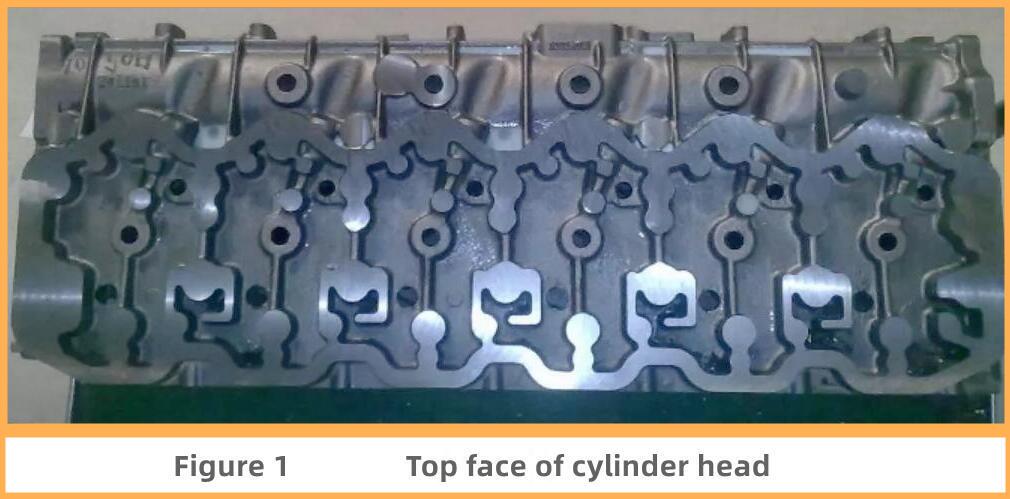
Figure 2 shows the bottom surface of the cylinder cover . Its main feature is that the surface distributes several holes. The cutting process is semi-continuous cutting.
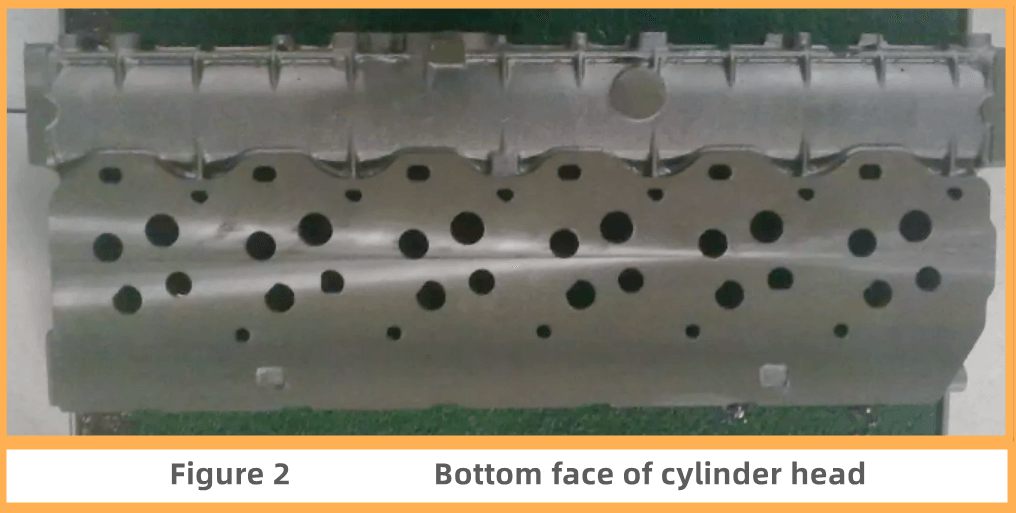
Figure 3 and 5 shows the structure of the test tools. The diameter of the cutter head is 200mm, and on the cutter head, it distributes 28 blade mounting positions, in which every 90° installing a polishing edge, and in the other 24 positions installing the cutting edge,
Figure 3 also shows the blade arrangement. The test requirements are: local flatness 0.05/100mm, surface roughness Ra=25μm, thickness 123.5±0.05mm; Test equipment: imported CNC horizontal machining center; Workpiece material: HT250; Workpiece hardness: 180-249HBw; Cutting area: 873mm×331mm; Processing allowance 0.5mm;
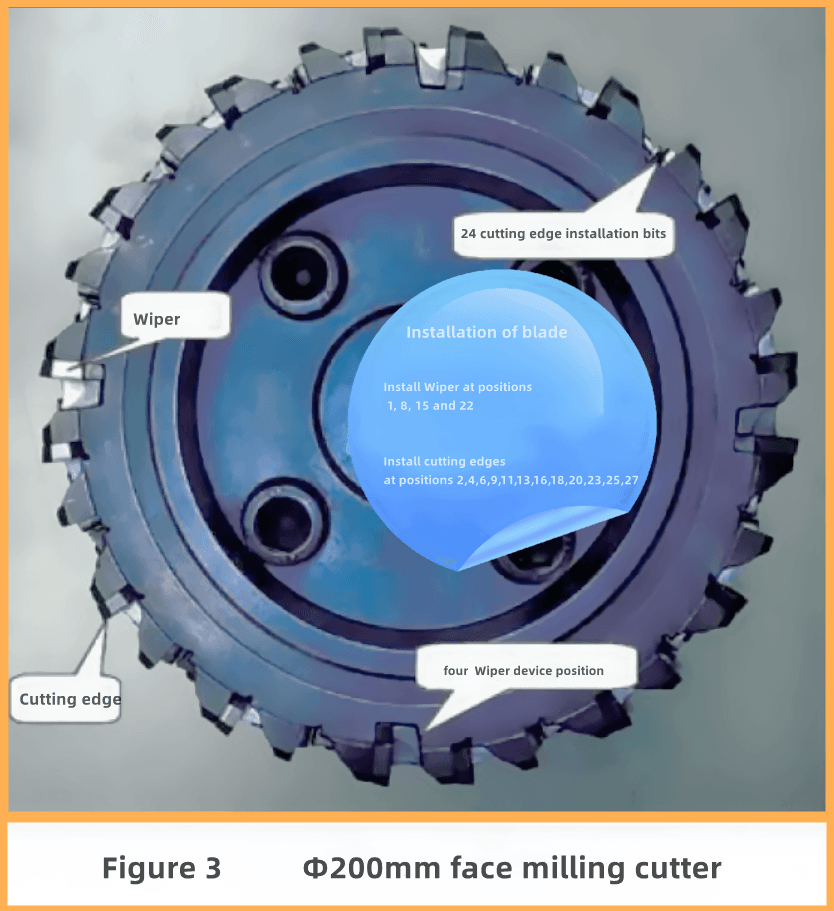
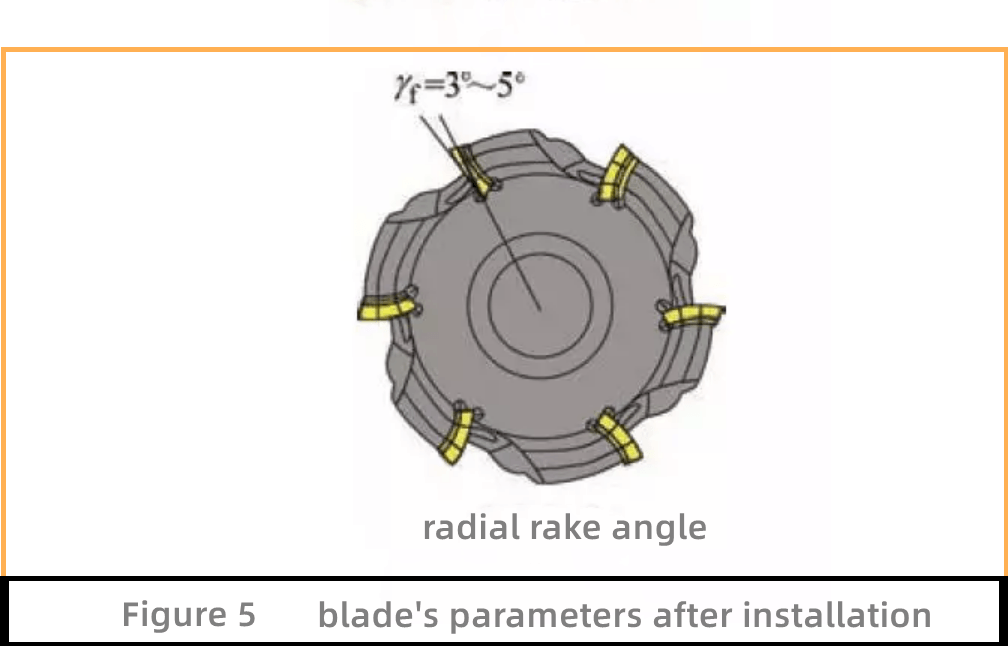
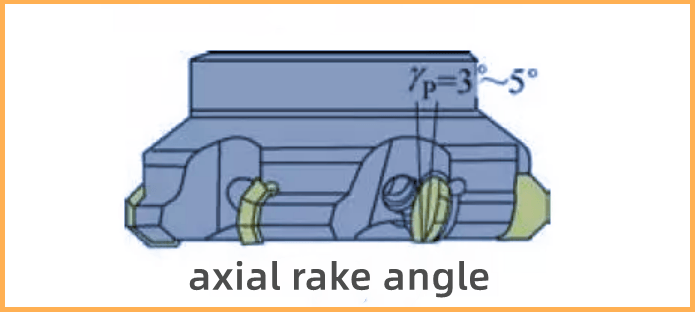
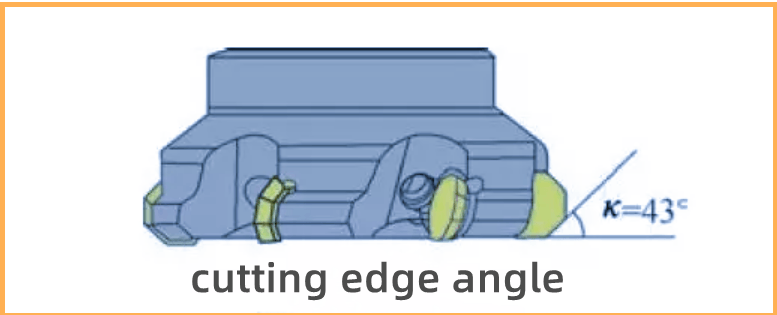
Figure 4(a) shows the cutting edge. The cutting-edge body is hard alloy, and the PCBN cutting edge is bonded to the cutting-edge body through brazing. The front Angle of the blade is 0°, the primary Angle is 45°, and the rear Angle is 11°. After installation, the radial and axial forward angles are 3° ~ 5°, and the tool cutting edge angle is 43°.
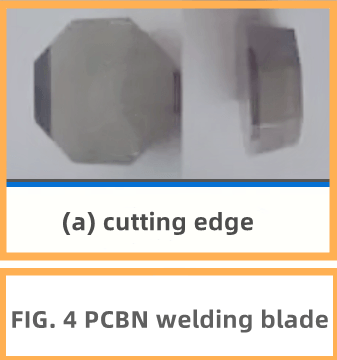
Figure 4(b) shows the polished edge. The cutting edge body is cemented carbide, and the PCBN cutting edge is brazed and bonded to the blade body. The front Angle of the blade is 0°, the central inclination Angle is 45°, and the back Angle is 11°. After installation, the radial and axial forward angles are 3° -5 °, and the tool cutting edge angle is 43°.
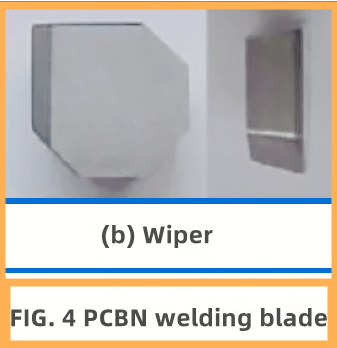
(2) Comparison of tool life between semi-continuous surface and discontinuous surface. The cutting tests on the top surface of cylinder cover were carried out twice, with the tool life of 200 and 242 workpieces respectively. The main failure forms were blade breakage, with the breakage rate of polishing edge reaching 100% and cutting edge breaking rate reaching 83%.
The cylinder cover bottom cutting test was carried out for a total of 8 times. The average life of the tool was 424.5 workpieces. The main failure form was blade breakage, of which the finishing edge breakage rate was 25%, and the cutting edge breakage rate was 29%.
The above test results show that, for the discontinuous surface such as the top surface of the cylinder cover, the cutting impact significantly influences the PCBN blade, and the PCBN blade breakage rate is too high, which is not suitable for the application of PCBN blade. When semi-continuous machining the surface of the cylinder head bottom, cutting impact affects the PCBN blade; the PCBN blade collapse rate is much lower than the cylinder cover top surface, such as the discontinuous surface.
(3) Failure mode of PCBN blade. During the test, the primary failure mode of the PCBN blade is blade collapse (see FIG. 6 and FIG. 7), while a small amount is cutting edge wear and the crucial part of the tool body cracking after abnormal stress at the critical point. The blade breakage cause the failure mode, which we believe is mainly caused by the following aspects:
① In the cutting process, the cutting edge is caused by the impact of intermittent cutting.
② The cutting force increases after the cutting edge abrasion, causing the edge to collapse.
③In the cutting process, the cutting edge meets the residual cutting fluid, which causes the edge to collapse due to the thermal impact. ④ The increasing cutting force after cutting edge wear causes the clamping point of the tool body to crack.
⑤ The cutting force continues to increase after the blade collapses, causing the clamping point of the tool body to crack. The cutting-edge brazing strength is insufficient and can not withstand the impact, causing the cutting-edge collapse.
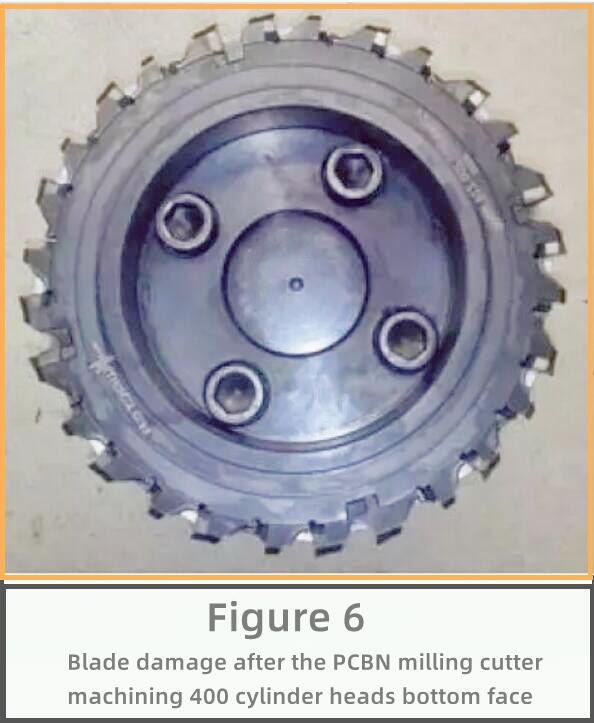
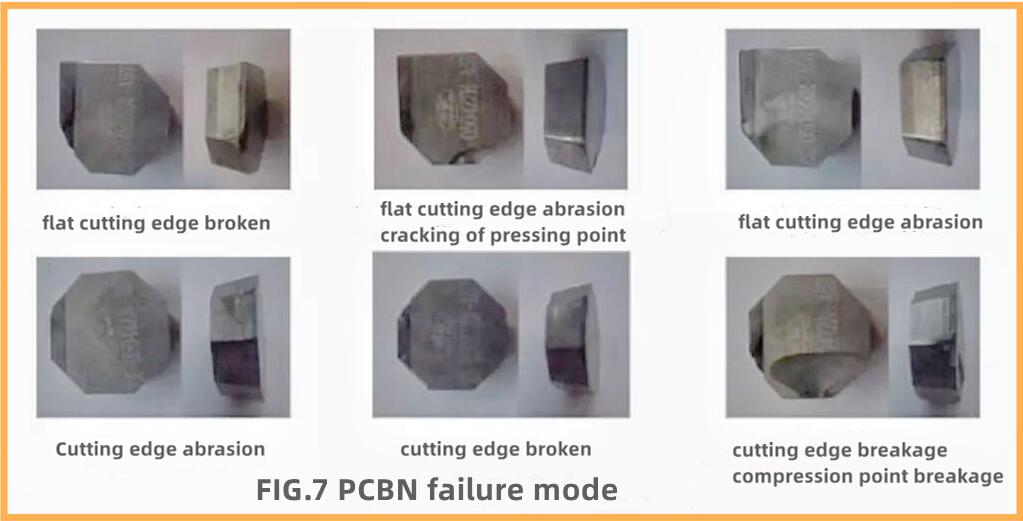
(4) The relationship between spindle power and blade wear. From the beginning of processing to processing the 150th workpiece, spindle power is relatively stable; From 150 to 200 workpieces, the spindle power starts to increase, indicating that the blade wear increases. Between 200 and 250 workpieces, the spindle power increases rapidly. When the 233rd workpiece is processed, 1 cutting edge breaks and 2 cutting edge breaks slightly; Between 250 and 400 workpieces, the breakage edge continues to increase, but the spindle power becomes stable again because the cutting edge of the blade after the breakage edge is equivalent to the state of the new edge. The blade failed when the 411 workpieces were processed, and the machined surface's quality worsened. After removal, there were accumulated nodules on the surface of the polished edge, 6 blades of the cutting edge cracked, and 8 blades burst.
(5) The relationship between cutting fluid and blade life
(6) Tool cost. According to the test conditions, After testing the semi-finishing of the bottom surface of the cylinder cover. A total of 4 sets of cutting edge blades (48 pieces in total) and 5 sets of polishing edge blades (20 pieces in total) were used in the test. A total of 3 396 workpieces were processed in 8 tests. The PCBN semi-finished single-piece time is the 40s, and the beat is reduced by 20s compared to the carbide blade.
For the cutting edge test, each cutting edge processing average is 425 pieces; each blade can be transposed once, and the average life of each piece is 849 pieces; the Polishing edge processing average is 679 pieces (not indexable).
Before the PCBN blade is ready to be put into use after the completion of the expansion test, it is necessary to establish the operating standards, which are specified as follows:
(1) The first cutting edge first edge edge breakage length does not exceed 1/3, can be used for transposition.
(2) According to the test results, the monitoring life of the milling cutter head is set as 1 200 hole surface (the number of actual machining pieces = monitoring life ÷ conversion coefficient, the conversion coefficient of the tool is equal to 3).
(3) After the first installation of the polishing edge, follow the cutting edge to the cutting edge life (400 workpieces, converted life of the machine tool 1 200), if there is no blade collapse and little wear, it is allowed to be used for the second time.
Through the PCBN milling cutter cutting test and application tracking, obtained PCBN milling cutter processing such as engine cylinder cover such a cast iron surface adaptability, failure mode of PCBN milling cutter, the relationship between spindle power and blade wear, the relationship between cutting fluid and blade life, production time and tool cost related results.
PCBN milling cutters are used in semi-fishing of the bottom of the cylinder cover. It solves the production line beat bottleneck, improves production efficiency, and reduces human resources, electricity, and other consumption, so it has a good application value. But the ability to further improve tool life remains developing.
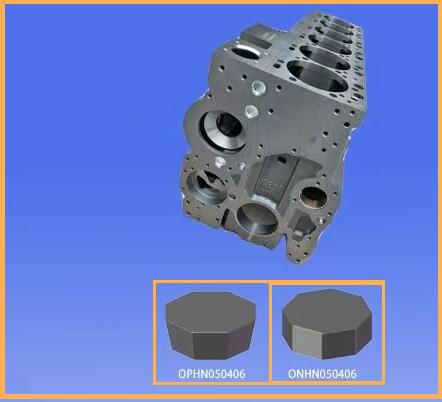 PCBN inserts finish-milling engine cylinder bottom and top surface
PCBN inserts finish-milling engine cylinder bottom and top surface
Machining mode: finish milling
Workpiece material: gray cast iron (HB180-250)
Recommended blade / insert: PCBN solid milling blade/insert
CBN Model:OPHN,ONHN
Cutting Parameters:
Vc=800-1200m/min
Ap = 0.5 mm
Fz/r = 0.08-0.12 mm
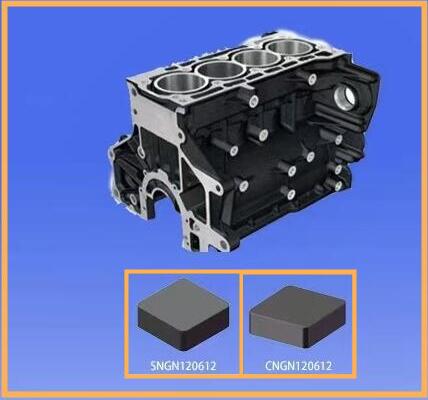
PCBN blade finish milling the top and bottom of engine cylinder block
Machining mode: finishing milling
Process name: bottom and top of engine cylinder block
Workpiece material: cast iron (HB180-250)
Recommended blade / insert: PCBN sintered milling blade/insert
Recommented Insert Model:OPHN,ONHN
Cutting parameters:
Vc=800-1200m/min
Ap=0.5mm
Fz/r = 0.08- 0.12 mm/r
Contact: Nina Qiao
Phone: 86-13526572721
E-mail: cutting@zy-superhardtools.com
Whatsapp:86-13526572721
Add: AUX Industry,Zhengzhou City,Henan Province,China
We chat
